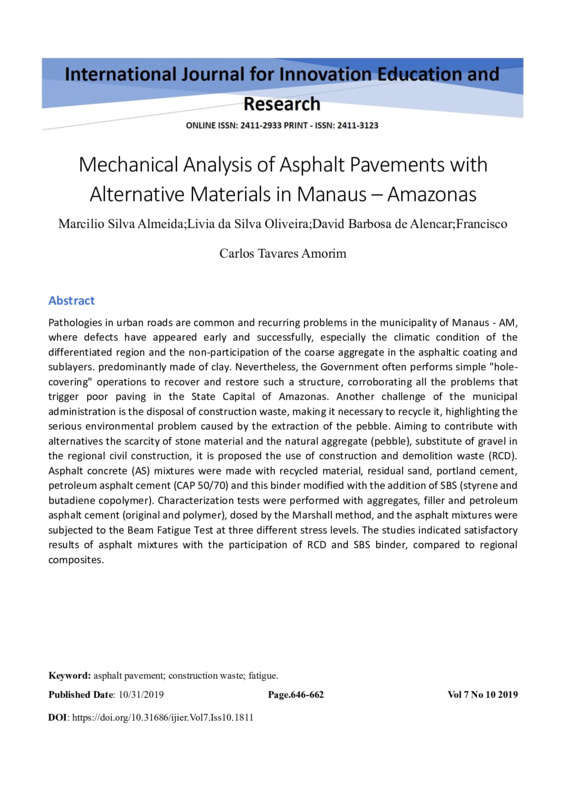Mechanical Analysis of Asphalt Pavements with Alternative Materials in Manaus – Amazonas
Item
-
Tipo do ITEM
-
Artigo Ciêntifico
-
Título do Artigo
-
Mechanical Analysis of Asphalt Pavements with Alternative Materials in Manaus – Amazonas
-
Descrição
-
Abstract
Pathologies in urban roads are common and recurring problems in the municipality of Manaus - AM,
where defects have appeared early and successfully, especially the climatic condition of the
differentiated region and the non-participation of the coarse aggregate in the asphaltic coating and
sublayers. predominantly made of clay. Nevertheless, the Government often performs simple "holecovering" operations to recover and restore such a structure, corroborating all the problems that
trigger poor paving in the State Capital of Amazonas. Another challenge of the municipal
administration is the disposal of construction waste, making it necessary to recycle it, highlighting the
serious environmental problem caused by the extraction of the pebble. Aiming to contribute with
alternatives the scarcity of stone material and the natural aggregate (pebble), substitute of gravel in
the regional civil construction, it is proposed the use of construction and demolition waste (RCD).
Asphalt concrete (AS) mixtures were made with recycled material, residual sand, portland cement,
petroleum asphalt cement (CAP 50/70) and this binder modified with the addition of SBS (styrene and
butadiene copolymer). Characterization tests were performed with aggregates, filler and petroleum
asphalt cement (original and polymer), dosed by the Marshall method, and the asphalt mixtures were
subjected to the Beam Fatigue Test at three different stress levels. The studies indicated satisfactory
results of asphalt mixtures with the participation of RCD and SBS binder, compared to regional
composites.
Keyword: asphalt pavement; construction waste; fatigue
-
Abstract
-
Abstract
Pathologies in urban roads are common and recurring problems in the municipality of Manaus - AM,
where defects have appeared early and successfully, especially the climatic condition of the
differentiated region and the non-participation of the coarse aggregate in the asphaltic coating and
sublayers. predominantly made of clay. Nevertheless, the Government often performs simple "holecovering" operations to recover and restore such a structure, corroborating all the problems that
trigger poor paving in the State Capital of Amazonas. Another challenge of the municipal
administration is the disposal of construction waste, making it necessary to recycle it, highlighting the
serious environmental problem caused by the extraction of the pebble. Aiming to contribute with
alternatives the scarcity of stone material and the natural aggregate (pebble), substitute of gravel in
the regional civil construction, it is proposed the use of construction and demolition waste (RCD).
Asphalt concrete (AS) mixtures were made with recycled material, residual sand, portland cement,
petroleum asphalt cement (CAP 50/70) and this binder modified with the addition of SBS (styrene and
butadiene copolymer). Characterization tests were performed with aggregates, filler and petroleum
asphalt cement (original and polymer), dosed by the Marshall method, and the asphalt mixtures were
subjected to the Beam Fatigue Test at three different stress levels. The studies indicated satisfactory
results of asphalt mixtures with the participation of RCD and SBS binder, compared to regional
composites.
Keyword: asphalt pavement; construction waste; fatigue
-
Língua do arquivo
-
inglês
-
Data da Publicação
-
Ano 2019
-
Palavra-chave
-
asphalt pavement
-
construction waste
-
fatigue
-
Autores
-
Marcilio Silva Almeida
-
Livia da Silva Oliveira
-
David Barbosa de Alencar
-
Francisco Carlos Tavares Amorim
-
Local
-
ITEGAM - Manaus, 2019


